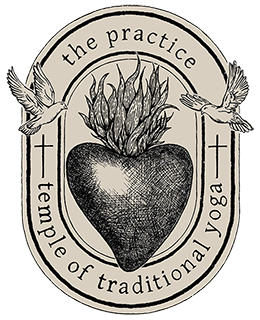by Octavio Salvado.
The opening words of the world’s oldest existing spiritual text are: “I meditate on the fire.” The Rig Veda dates back approximately 4500 years comprising channeled hymns received and recited by the ancient Seers in deep states of meditation. The access point for those deep, spiritual states was through a doorway – a doorway of fire.
We have been extremely blessed this past weekend, hosting Sri Rajasekaran and his son, Selvaganesan, two deekshitar priests from the Sri Nataraja Shiva temple in Chidambaram, South India who have been at The Practice sharing traditional Vedic knowledge through Agni Hotra (fire ceremony) and Mantra chanting. A ‘deekshitar’ is a hereditary priest, meaning that Sri Rajasekaran and Selva’s family have been tending the fires at India’s largest Shiva Nataraja temple since its time of origin over a thousand years ago.
In the spirit of keeping the tradition of Yoga alive in the modern world, it has been a great honor to host them at the Practice. This intention of maintaining authentic ties to lineage-based Yoga runs through the very center of The Practice and all that we stand for.
Yes, we are on a mission to keep the sacred torches of ancient times burning and yes, for now at least, we are perhaps a school of fired-eyed fish swimming against the collective current. That is ok, because we also believe that the tides are changing and that people are now beginning to tire of the body-based, call-anything-yoga culture that has all but drowned out the very thing giving Yoga its foundational integrity and potency.
One of the things I’m often asked about is the relationship between traditional Vedic Yoga involving fire worship and mantra, and what we practice today on the mat. The answer is a surprising one, as although it may look like modern Yoga has little semblance to the fire ceremonies and Yoga of old, in actuality, when practiced correctly they mirror one another perfectly.
What the ancients found is that the elements and energies that comprise nature and the universe are also the elements and energies that make up our own being. The macro mirrors the micro. If you can worship an external fire then you can worship an internal one, if that is, you know where to find it, how to activate it and most importantly, how to respectfully and devotionally honor it.
The essence of ‘practice as fire worship’ has largely been incinerated in modern times, usurped by the misguided desire to cultivate a peripheral, body-based heat. One of my teachers always says “Think about it, if Yoga – the science of awakening was about sweating and working out, wouldn’t every aerobics instructor be enlightened?” That is the current thinking of the majority – that the value of practice can be measured in sweat and external effort and complexity. Yet this approach to practice is moving us away from stillness and therefore away from sacredness.
Fire, both the inner and outer represent the height of sacredness. The Vedas go on to say, “I meditate on the fire, which allows me experience all of life as sacred. Here, within this sacred moment, I am both the ceremony itself and the priest dispensing the sacredness”. These sublime words resound from deep within the heart of the traditional Tantric Hatha Yoga path that states that through our own devotion and deep desire to reconnect with Source, we can become the priest through the ceremony of practice and systematically dispense the sacredness internally.
Yes, there is a system. The priest doesn’t carelessly throw the wood into the ‘Kund’ (fire-pit) or offer anything he likes into the flames. No, there is a wise progression to it, just as there is with practice. We cannot simply link poses together in any way we like (as is the case with a lot of modern vinyasa) and expect profound results. That is not how science works. If we truly want to activate the ‘inner’ Kund at the base of the spine (the sacrum) and the dormant power within it (Kund-alini), then we would be wise to know the rules of worship.

In Latin, sacrum means ‘sacred’. This is not a coincidence. Interestingly, the sacrum is the last bone in the body to burn. It can hold incredible amounts of heat and power – which is exactly what it does. The sacrum holds our dormant spiritual capacity know to the ancients as Kundalini Shakti. It is our spiritual essence and despite what you may have heard, it is not asleep. Divinity is never asleep. ‘We’ are asleep. Kundalini is waiting for ‘us’ to wake up. And that is what the fire ceremony is all about.
The progression is as follows:
First the Moon must be made steady, meaning that the mind must be made still. There are exact methods for achieving this in Hatha Yoga. There are specific poses, breathing ratios, meditations, bandhas, mudras and mantras to stabilize the Moon. Interestingly, these methods are essentially the opposite of what most modern yoga is teaching. Today’s yoga (for the most part anyway) does not build practitioners into solid meditators and here is the simple truth: if we don’t meditate, then we have no seat at the sacred fire-pit.
So awakening and stabilizing the Lunar-force is foundational – the first stage. Once steady, then the Sun can be made to rise. In other words, when the mind is made calm and clear through right application of practice, then we can begin to invoke and direct the higher energies (which of course requires a separate set of precise solarizing practices). It’s a science and each step allows us to collect the necessary offerings and tools required to prepare for the ceremony. Now, Moon steady and Sun shining bright, we can begin.
How is the inner fire worshipped? The same way the outer fire is worshipped, with wood, with wind and with ghee. Within the fire pit, the wood is placed. The wood symbolizes our mental and emotional debris – the stuff of the first three Chakras. The wood is the subconscious-mind; all of our worn out pattern, void of life and taking up space, weighing us down, keeping us tired, sick, lazy and uninspired. Between the abdomen and the tailbone we find our greatest obstacles to Self-realization and the kindling we need for the inner fire. This is why traditional Yoga postures and practices targeted this area so specifically. They were chopping the wood.
Once collected, it is the work of the out-breath along with the root lock, the navel lock and a mind skillful enough to visualize downward moving energy (Apana Vayu) turning upwards to offer the wood into the flames. Through these practices, the denser energies stored within the subtler layers of our being are drawn up into the psychic flames within the solar plexus – The Manipura Chakra.
The in-breath then fans the fire. Prana Vayu – the vital wind collected in the chest is contained by the chin lock and mentally directed downward. Together the wind, the wood and a heat birthed from the compression of opposites begins to ignite and the inner world enlivens. The truth of a sacred world engulfed by holy flames is revealed.
The ceremony has begun. Yet a ceremony is not a ceremony without ghee. Ghee is the blaze-bringer, the temple space illuminator. Once that pure, golden nectar slides from the wooden spoon into the lapping flame-like mouth of God, everything, absolutely everything lights up.
The ghee symbolizes and expresses our pure devotion, our unrefined-longing for God. Nothing in creation burns brighter than a Yogi’s deep, unflinching desire to touch the feet of the infinite. This is the highest purpose of practice and when we approach the ceremony of sadhana from this place, we ourselves become the priest and understand the truth of those opening words of the Vedas.
We also come to understand the innate connection between fire and mantra. As the holy text goes on to say “In the beginning was Brahman (God) with whom was the word.” Vibration (mantra) is right there at the beginning of it all. It is the first cause, the energetic blueprint of the universe itself. Even science now asserts that beneath the illusion of matter, there exists a vibrant sea of energy in motion.
What the Yoga tradition suggests is that once we activate the inner fire, we will hear the music – the inaudible sound currents supporting material life, giving everything its unique form holding every single atom and molecule in place.
To be clear, Yogis didn’t create mantras. We can chant them and perhaps if we practice devotionally, we can hear them echoing through the ether, but we did not create them, anymore than we created sunlight. Mantras predate us and everything else. Mantra (vibration) is the spine of life and the essential energetic emanation of the sacred force of fire. If there were no mantras, there would be no universe.
Meditation on the fire is the means. Mantra is the result.
The whole path of Yoga, yoking the Moon and Sun, stoking the ceremonial Fire, all of it is a movement towards meditation and ultimately the absorption of the mind into the silent sound waves of mantric code. Verbal chanting is powerful, yet it is only the first stage.
The essence of Mantra-meditation is getting quiet enough, pure enough (pure as golden ghee) and devoted enough to experience the mantras in their original form – their purest form – right there, pulsing out of you, out of your eyes and heart, reverberating as you and everything around you. This is what it means to Meditate on the Fire. It is about getting silent enough to hear the eternal love song of God and the sublime whisperings of your own beautiful soul.
So if the sacred ceremony of your practice isn’t sinking you deep into the sound of silence, then let it burn away. Liberate it. You are designed and destined for more. You are a spark of the Infinite One and your dharma, your fundamental reason for being here is to ignite.
So burn, baby, burn and watch the world light up around you.
